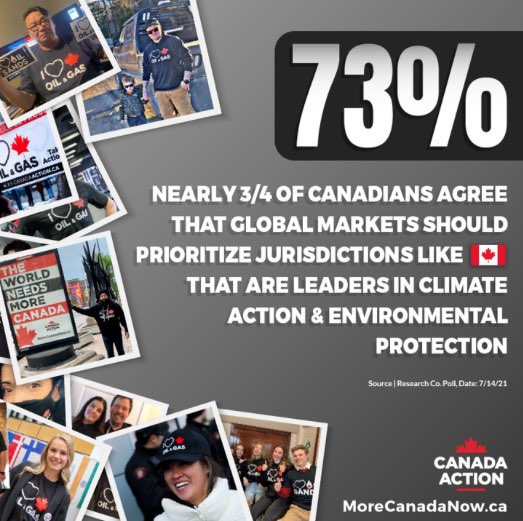Alberta
New opinion surveys reveal overwhelming majority of Canadians support our Oil and Gas industry

News Release from Canada Action
We are very excited to share some recent and encouraging polling results today. According to a July 2021 public opinion survey conducted by Research Co, new data shows that Canada’s public perception of our responsible energy industry is very positive.
Here are some of the key findings:
- Almost three in four (73 percent) Canadians polled agree Canada should be a preferred global supplier of energy because of its climate and environmental record.
- Nearly seven in ten (69 percent) say they have personally benefited from the oil and gas sector.
- 70 percent agree that resource development could help alleviate systemic poverty within Indigenous communities.
- Two thirds of Canadians (66 percent) support Canada’s role as a global oil and gas supplier.
- Almost three in four Canadians (73 percent) acknowledge Canada’s prosperity is supported by the oil and gas sector and that Canadian oil and gas production helps fund important social programs like health care and education.
Referring to the fact 73 percent of Canadians polled also agreed it’s essential First Nations be included in project development to establish long-term revenue sources for their communities, JP Gladu, acting Executive Director of Indigenous Resource Network, noted the following:
Taken collectively, this is all exceptional news for all of Canada’s natural resource industries. Your support for our positive, fact based message about why the world needs more Canadian energy and resources is helping make a difference.
A Majority of Canadians ‘Agree’ that Canada Should be a Preferred Global Supplier of Energy: POLL

A new public opinion survey conducted by Research Co. on behalf of Canada Action has found that a majority of Canadians across the country support the vital oil and gas sector! The poll, released on July 14th, showed that 68% of participants ‘agree’ that Canada should be the choice supplier to meet future oil and gas demand, while two-thirds (66%) support Canada’s role as a global oil and gas supplier versus just 19% who were opposed.
Additionally, almost three in four Canadians (73%) acknowledged Canada’s prosperity is supported by the oil and gas sector and that the industry helps fund important social programs such as healthcare and education.
“It’s a strong and very welcome result, and one that shows most Canadians feel proud of the work their energy sector is doing to enhance its record on ESG criteria. The results also show most Canadians believe the world needs more Canadian energy and are aware of the importance of the sector to the prosperity of families and communities right across the country,” said Cody Battershill, Canada Action founder.

Between 2000 and 2018, approximately $493 billion in government revenues were generated by Canada’s oil and gas industry, capital which has been used pay for schools, hospitals, roads and the workers that make these projects possible/operational. Every Canadian has benefitted from oil and gas in some way, shape, or form; nearly seven-in-ten Canadians (69%) of participants also acknowledged that Canada’s oil and gas sector has benefitted them personally.
Nearly three-in-four Canadians (73%) also agreed that global markets should prioritize jurisdictions like Canada that are leaders in climate action and environmental protection. This is a logical choice as Canada’s oil and gas industry ranks number one for Environmental, Social, and Governance (ESG) practices among nations with the largest oil reserves, and of the world’s top 20 producers, 2nd for governance and social progress and 4th on the environment.
“Given the world requires $525 billion of new oil and gas investment per year just to meet current demand, we think we ought to push for Canada to receive a sizeable share of this investment,” Battershill added.

Canada’s world-class ESG performance shows that our nation is home to one of the most environmentally conscious and sustainable oil and gas industries in the world. With future supply gaps on the horizon, it only makes sense that ESG-focussed investors look to Canada as a choice supplier for as long as the world needs oil – and it will for many decades to come.
73% of participants also agreed that it’s essential First Nations be included in project development to establish long-term revenue sources for their communities.
“These are heartening results. Indigenous nations and businesses want to be partners in resource development. This poll shows there’s widespread support to work together for the benefit of all,” said JP Gladu, acting Executive Director of the Indigenous Resource Network.
Below is a summary of all poll results collected by Research Co.
Poll Results:

– Two-thirds of Canadians (66%) support Canada’s role as a global oil and gas supplier, while one-in-five (19%) are opposed
– Almost seven-in-ten Canadians (69%) say the oil and gas industry has benefitted them personally
– Almost three-in-four Canadians (73%) agree that global markets should prioritize jurisdictions like Canada that are leaders in climate action and environmental protection
– Almost three-in-four Canadians (73%) agree that Canadian oil and gas products help fund important social programs like healthcare and education for Canadians
– More than seven-in-ten Canadians (72%) agree that sustainability measures are better served when energy is sourced from Canada compared to less environmentally friendly jurisdictions

– Seven-in-ten Canadians (70%) agree that Canada should be the choice recipient of investments due to its climate leadership and environmental policies
– More than two-thirds of Canadians (68%) agree that Canada should be the choice supplier to meet future oil and gas demand
– Over three-in-five Canadians (64%) agree that investing in Canada’s oil and gas sector makes sense if you value climate leadership, social progress and transparency
– Fewer than half of Canadians (45%) were aware that Canada is a leader for environmental, social and governance (ESG) practices among countries with the largest oil and gas reserves
– More than two-in-five Canadians (43%) were aware that Canadian energy companies are global leaders in carbon capture, utilization and storage

– Just over two-in-five Canadians (41%) were aware that Canadian natural gas exported to Asia can reduce global emissions by displacing coal power usage
– Almost three-in-four Canadians (73%) agree that global markets should prioritize jurisdictions like Canada that are leaders in climate leadership and environmental protection
– Almost three-in-four Canadians (73%) agree that Canada should be a destination of choice for energy investment due to its climate leadership, worker safety and environmental policies
– More than two-thirds of Canadians (68%) agree that Canada should be the choice supplier to meet future oil and gas demand
– Almost three-in-four Canadians (74%) think Canada should act in a similar fashion to Norway when it comes to energy practices, as the nation has said they will continue to maximize the value created from their oil and gas reserves

– Almost three-in-four Canadians (73%) agree that Canada’s prosperity is supported by the oil and gas sector practices
– Almost three-in-four Canadians (73%) agree that it is essential that First Nations be included in project development to establish long-term revenue sources for their communities
– Seven-in-ten Canadians (70%) agree that Systemic poverty within Indigenous communities could be alleviated with resource development
– Almost seven-in-ten Canadians (69%) agree that Indigenous and non-Indigenous communities in Canada should play a role in supplying our energy to meet domestic and global demands
– More than half of Canadians (56%) agree with the decision related to the TMX expansion, while one-in-five (21%) disagree, and a similar proportion (22%) are undecided. Support for the decision is highest in Alberta and Atlantic Canada (each at 63%), followed by Ontario (57%), Saskatchewan and Manitoba (56%), British Columbia (55%) and Quebec (52%)
– Over three-in-five Canadians (62%) think the Indigenous communities support the Trans Mountain Pipeline (TMX) project
– More than three-in-ten Canadians (31%) are more likely to support the Trans Mountain expansion upon learning of the views of Indigenous communities, while 7% are less likely to support. More than two-in-five (47%) say their position has not changed as a result of this fact
Results were based on an online study among 1,000 adults in Canada, conducted July 7 to 9, 2021 and weighted for age, gender and region. The margin of error—which measures sample variability—is +/- 3.1 percentage points, nineteen times out of twenty.
Join Us Today!
Learn more about Canada’s sustainable energy industry by joining us on Facebook, Twitter, and Instagram today – hope to see you there!
Back to Energy – Canada Action
Alberta
Alberta government records $8.3 billion surplus—but the good times may soon end

From the Fraser Institute
By Tegan Hill
According to last week’s fiscal update, the Smith government recorded a $8.3 billion surplus in 2024/25—$8 billion more than what the government projected in its original 2024 budget. But the good times won’t last forever.
Due largely to population growth, personal income tax revenue exceeded budget projections by $500 million. Business tax revenue exceeded budget expectations by $1.1 billion. And critically, thanks to relatively strong oil prices, resource revenue (e.g. oil and gas royalties) saw a $4.7 billion jump.
The large budget surplus is good news, particularly as it will be used to pay down government debt (which taxpayers must ultimately finance) and to invest for the future. But again, the good times could soon be over.
Recall, the Alberta government incurred a $17.0 billion budget deficit just a few years ago in 2020/21. And it wasn’t only due to COVID—until the recent string of surpluses, the government ran deficits almost every year since 2008/09, racking up significant amounts of debt, which still largely persists today. As a result, provincial government debt interest payments cost each Albertan $658 in 2024/25. Moreover, in February’s budget, the Smith government projected more deficits over the next three years.
Generally, Alberta’s fiscal fortunes follow the price of oil. Over the past decade, for example, resource revenue has been as low as $2.8 billion in 2015/16, while oil prices slumped to $US45.00 per barrel, and as high as $25.2 billion in 2022/23, when oil prices jumped to $US89.69 per barrel.
Put simply, resource revenue volatility fuels Alberta’s boom-and-bust cycle. In 2025/26, the West Texas Intermediate oil price will be a projected $US68.00 per barrel with projected resource revenue falling by $4.9 billion year-over-year.
But oil prices don’t need to dictate Alberta’s fiscal fortune. Indeed, if the Smith government restrains its spending, it can avoid deficits even when resource revenues fall.
There are plenty of ways to rein in spending. For instance, the government spends billions of dollars in subsidies (a.k.a. corporate welfare) to select industries and businesses in Alberta every year despite a significant body of research that shows these subsidies fail to generate widespread economic benefit. Eliminating these subsidies is a clear first step to deliver significant savings.
The budget surplus is undoubtedly positive for Albertans, but the good times could soon come to an end. To avoid deficits and debt accumulation moving forward, the Smith government should rein in spending.
Alberta
Alberta Provincial Police – New chief of Independent Agency Police Service

Sat Parhar has been appointed as the first chief of the Independent Agency Police Service, marking the next step toward a new municipal policing option.
The appointment of a new chief for the Independent Agency Police Service (IAPS) marks the next step in giving municipalities a new option for local policing and builds on the work already underway for the agency to assume the police-like duties currently carried out by the Alberta Sheriffs. The IAPS will empower municipalities to adopt strategies that effectively respond to their specific safety concerns, enhancing public safety across the province.
Chief Parhar brings more than 25 years of policing experience, including senior roles with the Calgary Police Service, most recently as deputy chief. His frontline policing experience and deep understanding of Alberta’s complex and diverse public safety landscape positions him to lead the agency as it takes shape and begins its work as a new municipal policing option, keeping communities safe.
Once operational, the agency will strengthen Alberta’s existing policing model and complement the province’s current police services, which includes the RCMP, Indigenous policing services and municipal police. It will help fill gaps and ensure law enforcement resources are deployed efficiently to meet Alberta’s evolving public safety needs and improve law enforcement response times, particularly in rural communities.
“Appointing Chief Sat Parhar is a key milestone in Alberta’s plan to give municipalities a real choice in how their communities are kept safe. This is about building a modern police service that reflects the priorities of Albertans, strengthens local decision-making, and ensures every corner of our province, especially rural areas, can count on responsive, effective law enforcement. With his decades of experience and deep understanding of Alberta’s policing landscape, he is the right leader to bring this vision to life.”
“This appointment signifies a significant step forward in our efforts to establish a more robust, community-focused policing model that is better equipped to meet the unique needs of our local residents. Under Chief Parhar’s visionary leadership, we are confident that we will develop a modern, efficient police service that not only enhances public safety but also aligns closely with the priorities and values of Albertans. His experience and commitment are vital in shaping an IAPS that is responsive, transparent, and dedicated to fostering trust and collaboration within the community, ultimately ensuring a safer and more connected society for all.”
Chief Parhar’s immediate priorities will be to hire an executive team and commence organizational planning such as developing key recruitment, training and other operational policies. Chief Parhar’s appointment is the first step of many to establishing the IAPS.
“It’s an honour to take on this role and help shape a modern police service built for Alberta. My focus from day one will be on setting high standards for professionalism, building strong relationships with our partners and ensuring this service reflects the needs and priorities of the communities we serve.”
The Independent Agency Police Service was formally created through regulation following the passing of Public Safety Statutes Amendment Act, 2024. The agency will operate as an independent Crown corporation, and will be renamed the Alberta Sheriffs Police Service, with its head office located in Calgary. The IAPS will be operationally independent from the provincial government with civilian oversight, consistent with all police services in Alberta.
“When it comes to policing, municipalities like ours deserve a choice – especially when the current system leaves us disadvantaged simply because of our size. We look forward to learning more about what that alternative will look like once an Alberta police agency is fully established and the options are clear. For us, this is about fairness, sustainability, and ensuring municipalities have access to policing solutions that reflect both their needs and their realities.”
Quick facts
- The regulation establishes the IAPS Provincial Corporation and its governance structure including board of directors, board of director powers, financial responsibilities and accountabilities.
Related news
- Expanding municipal police service options (April 7, 2024)
-

 Business2 days ago
Business2 days agoLatest shakedown attempt by Canada Post underscores need for privatization
-

 Business2 days ago
Business2 days agoWhy it’s time to repeal the oil tanker ban on B.C.’s north coast
-

 Alberta2 days ago
Alberta2 days agoPierre Poilievre – Per Capita, Hardisty, Alberta Is the Most Important Little Town In Canada
-

 MxM News2 days ago
MxM News2 days agoUPenn strips Lia Thomas of women’s swimming titles after Title IX investigation
-

 Alberta1 day ago
Alberta1 day agoAlberta Provincial Police – New chief of Independent Agency Police Service
-

 Energy2 days ago
Energy2 days agoIf Canada Wants to be the World’s Energy Partner, We Need to Act Like It
-

 International2 days ago
International2 days agoCBS settles with Trump over doctored 60 Minutes Harris interview
-

 Crime2 days ago
Crime2 days agoBryan Kohberger avoids death penalty in brutal killing of four Idaho students








